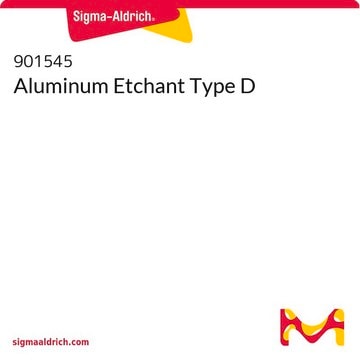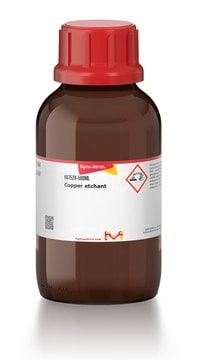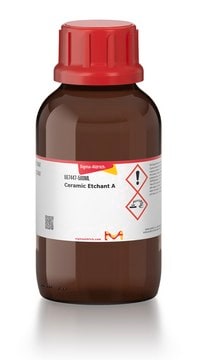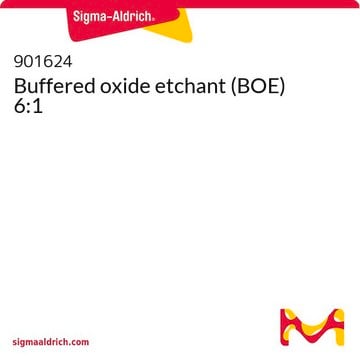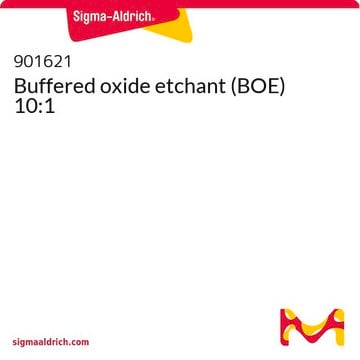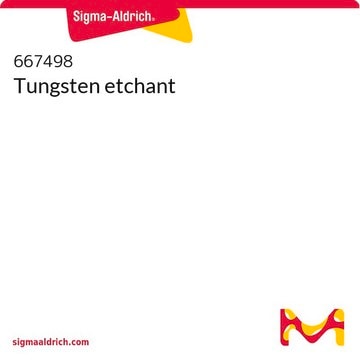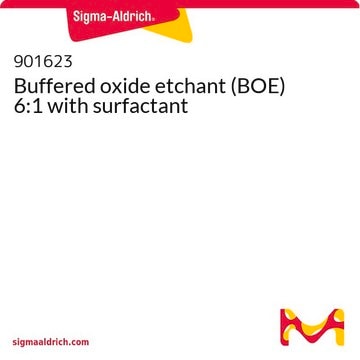Products may be shipped at a different temperature than the recommended long-term storage temperature. If the product quality is sensitive to short-term exposure to conditions other than the recommended long-term storage, it will be shipped on wet or dry-ice. If the product quality is NOT affected by short-term exposure to conditions other than the recommended long-term storage, it will be shipped at ambient temperature. As shipping routes are configured for minimum transit times, shipping at ambient temperature helps control shipping costs for our customers. For more information, please refer to the Storage and Transport Conditions document: https://www.sigmaaldrich.com/deepweb/assets/sigmaaldrich/marketing/global/documents/316/622/storage-transport-conditions-mk.pdf
901539
Aluminum Etchant Type A
Synonym(s):
Aluminum etching solution for use on silicon devices
About This Item
Recommended Products
form
liquid
Related Categories
General description
- Standard aluminum etchant for use on silicon devices and other microelectronic applications.
- Aluminum etchants are stable, non-toxic preparations used to etch aluminum metallizations on silicon devices and in integrated circuit applications. Aluminum contacts are defined, and interconnections are formed. These aluminum etchants, formulated with unique properties, easily overcome many of the difficulties experienced in aluminum etch processes.
- The aluminum metallization and etching process using photo-lithographic techniques is basic to semiconductor and microelectronic technology. Aluminum etchants are highly compatible with commercial photoresists and permit delineation into high resolution patterns. Metal line width of 1 mil and separations less than 5 microns are feasible. High resolution is practical with these aluminum etchants because lifting of photoresist patterns does not occur and undercutting is minimized. Furthermore, the etchants do not attack silicon, silicon dioxide, silicon nitride or nichrome resistor films.
- Two aluminum etchants are offered for use in microelectronics. Type A is recommended for use on silicon devices. Type D is recommended for use on gallium arsenide and gallium phosphide devices to avoid attack of the etchant on the intermetallic compound. It is also recommended for etching aluminum metallizations on nichrome thin film resistors.
Application
- Aluminum metallizations up to 25,000 Å are vacuum deposited on the silicon slice, coated with a photoresist, and UV exposed using an appropriate photographic mask. The resist is developed to protect the aluminum where interconnections are desired. Then the unprotected areas of the aluminum are removed by etching with the aluminum etchant, followed by a water rinse.
- Etching time is dependent upon the etchant temperature and the aluminum film thickness. When etching thick aluminum films, a higher etch rate is required; thus a higher etchant temperature should be used. Likewise, for thinner aluminum films, slower etch rates are desired and a lower etchant temperature should be chosen.
- At a specific etchant temperature, the etching time is given by the following formula:
where Etch Rate at 25°C 30 Å/sec; at 40°C 80 Å/sec.
Features and Benefits
- Controlled etch rates
- Selective etching: will not attack SiO2 or Si3N4
- Offers high resolution with minimal undercutting
- Eliminates smut formation
- Economical; reusable
Signal Word
Danger
Hazard Statements
Precautionary Statements
Hazard Classifications
Acute Tox. 4 Oral - Eye Dam. 1 - Met. Corr. 1 - Skin Corr. 1
Supplementary Hazards
Storage Class Code
8A - Combustible corrosive hazardous materials
WGK
WGK 1
Flash Point(F)
Not applicable
Flash Point(C)
Not applicable
Choose from one of the most recent versions:
Already Own This Product?
Find documentation for the products that you have recently purchased in the Document Library.
Customers Also Viewed
-
How is shipping temperature determined? And how is it related to the product storage temperature?
1 answer-
Helpful?
-
-
How can I determine the shelf life / expiration / retest date of this product?
1 answer-
If this product has an expiration or retest date, it will be shown on the Certificate of Analysis (COA, CofA). If there is no retest or expiration date listed on the product's COA, we do not have suitable stability data to determine a shelf life. For these products, the only date on the COA will be the release date; a retest, expiration, or use-by-date will not be displayed.
For all products, we recommend handling per defined conditions as printed in our product literature and website product descriptions. We recommend that products should be routinely inspected by customers to ensure they perform as expected.
For products without retest or expiration dates, our standard warranty of 1 year from the date of shipment is applicable.
For more information, please refer to the Product Dating Information document: https://www.sigmaaldrich.com/deepweb/assets/sigmaaldrich/marketing/global/documents/449/386/product-dating-information-mk.pdfHelpful?
-
Active Filters
Our team of scientists has experience in all areas of research including Life Science, Material Science, Chemical Synthesis, Chromatography, Analytical and many others.
Contact Technical Service